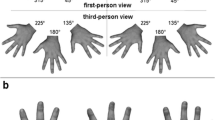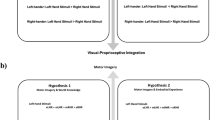Abstract
Determining the handedness of visually presented stimuli is thought to involve two separate stages—a rapid, implicit recognition of laterality followed by a confirmatory mental rotation of the matching hand. In two studies, we explore the role of the dominant and non-dominant hands in this process. In Experiment 1, participants judged stimulus laterality with either their left or right hand held behind their back or with both hands resting in the lap. The variation in reactions times across these conditions reveals that both hands play a role in hand laterality judgments, with the hand which is not involved in the mental rotation stage causing some interference, slowing down mental rotations and making them more accurate. While this interference occurs for both lateralities in right-handed people, it occurs for the dominant hand only in left-handers. This is likely due to left-handers’ greater reliance on the initial, visual recognition stage than on the later, mental rotation stage, particularly when judging hands from the non-dominant laterality. Participants’ own judgments of whether the stimuli were ‘self’ and ‘other’ hands in Experiment 2 suggest a difference in strategy for hands seen from an egocentric and allocentric perspective, with a combined visuo-sensorimotor strategy for the former and a visual only strategy for the latter. This result is discussed with reference to recent brain imaging research showing that the extrastriate body area distinguishes between bodies and body parts in egocentric and allocentric perspective.





Similar content being viewed by others
Notes
In general, reaction time data show a log normal distribution. The analyses were repeated using log-transformed reaction times; all effects remain the same and at comparable levels of significance. We report the analyses for untransformed RT in the main text for consistency with previous research.
While ANOVA is often performed on error data in psychological research, caution is advised as these data are not normally distributed and are naturally bounded between 0 and 100%. Reanalyses using arcsine square root transformed data for the right-handed group also showed a main effect of Orientation, P ~ 0, and a significant Laterality by Condition interaction, P = 0.003. For the left-handed group analyses with transformed data showed a main effect of Orientation, P ~ 0, while the main effect of Condition is not significant after transformation, P = 0.12. We report the analyses for untransformed RT in the main text for consistency with previous research.
Over the range of egocentric orientations (0°, 45°, 90°, 315°), the proportion of trials on which participants rated the hands as belonging to ‘other’ was very small, making for poor estimates of RT. Similarly, for allocentric orientations (135°, 180°, 225°), the proportion of trials on which participants rated the hands as belonging to ‘self’ was very small. As such, only the solid bars give accurate estimates of the time to rate hands as either ‘self’ or ‘other’, these judgments being naturally tied to egocentric and allocentric orientations respectively.
References
Bakeman R (2005) Recommended effect size statistics for repeated measures designs. Behavior Research Methods 37(3):379–384
Chan AW-Y, Peelen MV, Downing PE (2004) The effect of viewpoint on body representation in the extrastriate body area. Neuro Report 15:2407–2410
Conson M, Aromino AR, Trojano L (2010) Whose hand is this? Handedness and visual perspective modulate self/other discrimination. Exp Brain Res 206(4):449–453
Cooper LA, Shepard RN (1975) Mental transformations in the identification of left and right hands. J Exp Psychol Human 1:48–56
de Lange FP, Helmich RC, Toni I (2006) Posture influences motor imagery: an fMRI study. NeuroImage 33:609–617
Fiorio M, Tinazzi M, Aglioti SM (2006) Selective impairment of hand mental rotation in patients with focal hand dystonia. Brain 129:47–54
Gentilucci M, Daprati E, Gangitano M (1998a) Implicit visual analysis in handedness recognition. Conscious Cogn 7:478–493
Gentilucci M, Daprati E, Gangitano M (1998b) Right-handers and left-handers have different representations of their own hand. Cognit Brain Res 6:185–192
Ionta S, Blanke O (2009) Differential influence of hands posture on mental rotation of hands and feet in right and left handers. Exp Brain Res 195:207–217
Ionta S, Fourkas AD, Fiorio M, Aglioti SM (2007) The influence of hands posture on mental rotation of hands and feet. Exp Brain Res 183:1–7
Kosslyn SM, DiGirolamo GJ, Thompson WL, Alpert NM (1998) Mental rotation of objects versus hands: neural mechanisms revealed by positron emission tomography. Psychophysiology 35:151–161
Myers A, Sowden PT (2008) Your hand or mine? The extrastriate body area. NeuroImage, 42, 1669–1677 motor imagery: An fMRI study. Neuro Image 33:609–617
Nico D, Daprati E, Rigal F, Parsons L, Sirugu A (2004) Left and right hand recognition in upper limb amputees. Brain 127:120–132
Oldfield RC (1971) The assessment and analysis of handedness: the Edinburgh inventory. Neuropsychologia 9:97–113
Parsons LM (1987) Imagined spatial transformations of one’s hands and feet. Cognitive Psychol 19:178–241
Parsons LM (1994) Temporal and kinematic properties of motor behaviour reflected in mentally simulated action. J Exp Psychol Human 20:709–730
Parsons LM, Fox PT, Downs JH, Glass T, Hirsch TB, Martin CC, Jerabek PA, Lancaster JL (1995) Use of implicit motor imagery for visual shape discrimination as revealed by PET. Nature 375:54–58
Parsons LM, Gabrieli JDE, Phelps EA, Gazzaniga MS (1998) Cerebrally lateralised mental representations of hand shape and movement. J Neurosci 18:6539–6548
R Development Core Team (2010) R: a language and environment for statistical computing. R Foundation for Statistical Computing, Vienna, Austria. ISBN 3-900051-07-0, URL http://www.R-project.org
Saxe R, Jamal N, Powell L (2006) My body or yours? The effect of visual perspective on cortical body representations. Cereb Cortex 16:178–182
Schwoebel J, Coslett HB (2005) Evidence for multiple, distinct representations of the human body. J Cognitive Neurosci 17:543–553
Shenton JT, Schwoebel J, Coslett HB (2004) Mental motor imagery and the body schema: evidence for proprioceptive dominance. Neurosci Lett 370:119–124
Takeda K, Shimoda N, Sato Y, Ogano M, Kato H (2010) Reaction time differences between left- and right-handers during mental rotation of hand pictures. Laterality 15:415–425
ter Horst AC, van Lier R, Steenbergen B (2010) Mental rotation task of hands: differential influence number of rotational axes. Exp Brain Res 203(2):347–354
Acknowledgments
We thank two anonymous reviewers for their comments on previous version of this paper. Any errors are ours.
Author information
Authors and Affiliations
Corresponding author
Rights and permissions
About this article
Cite this article
Ní Choisdealbha, Á., Brady, N. & Maguinness, C. Differing roles for the dominant and non-dominant hands in the hand laterality task. Exp Brain Res 211, 73–85 (2011). https://doi.org/10.1007/s00221-011-2652-9
Received:
Accepted:
Published:
Issue Date:
DOI: https://doi.org/10.1007/s00221-011-2652-9




